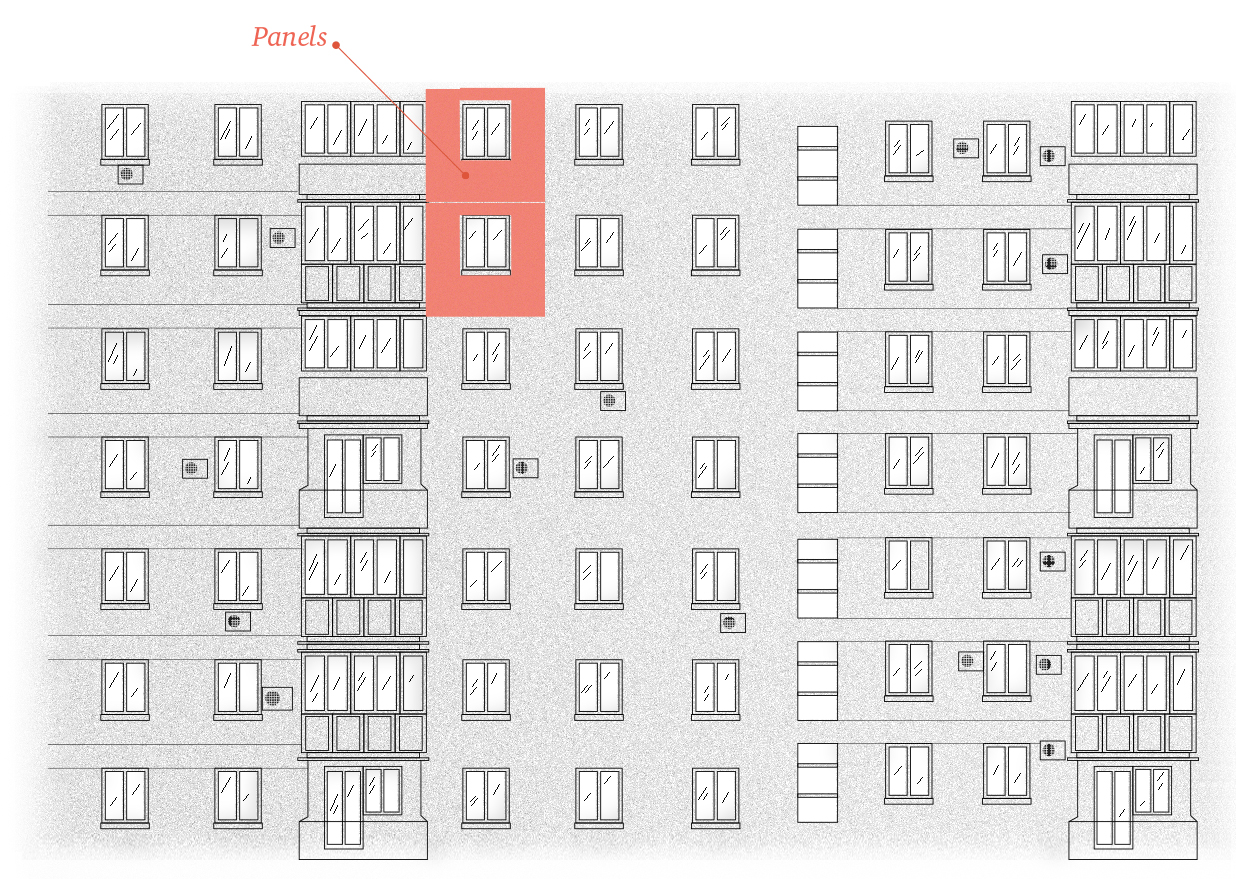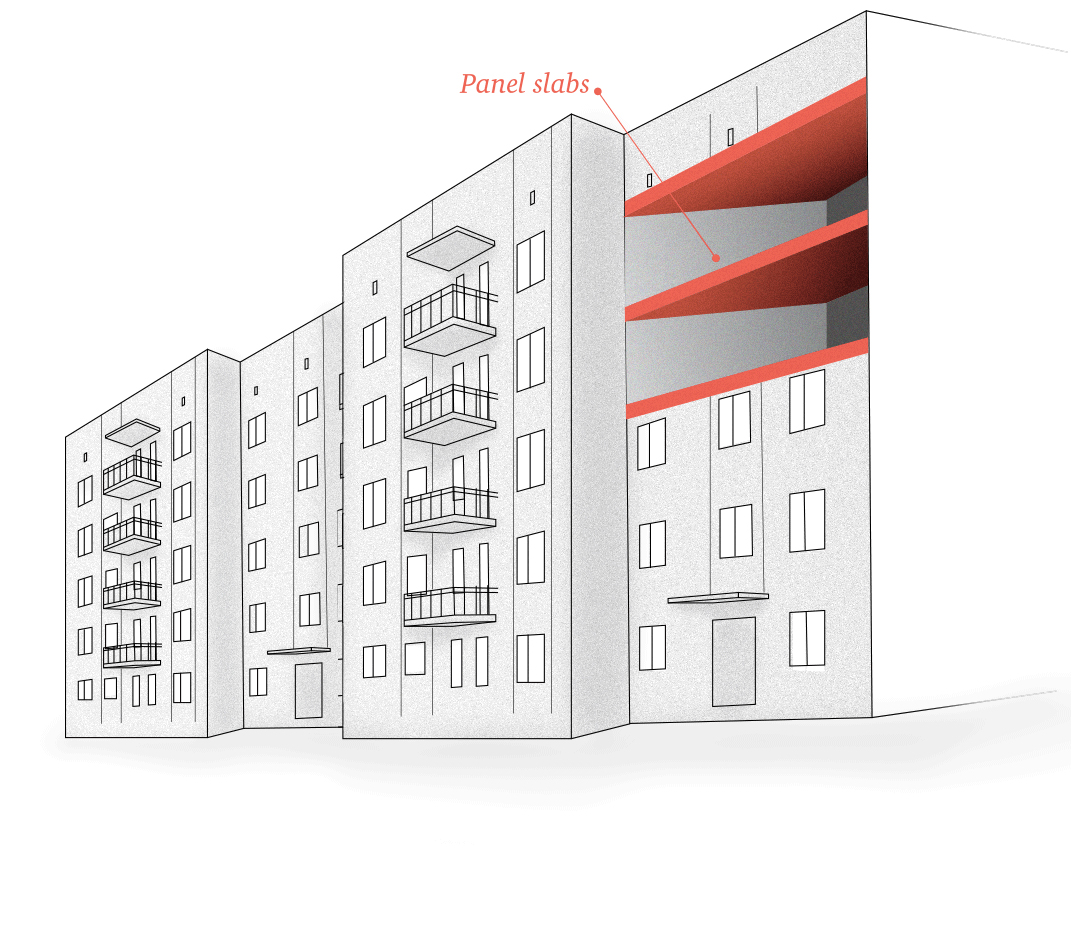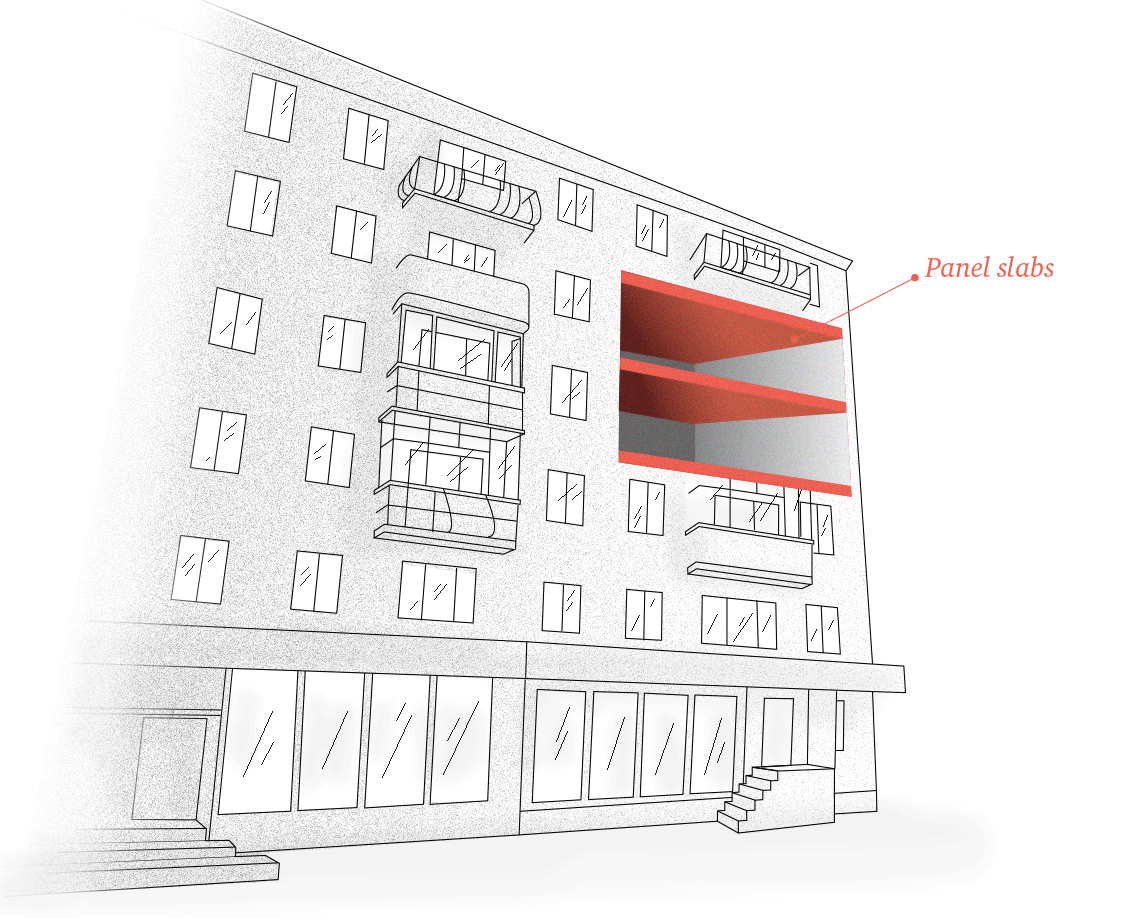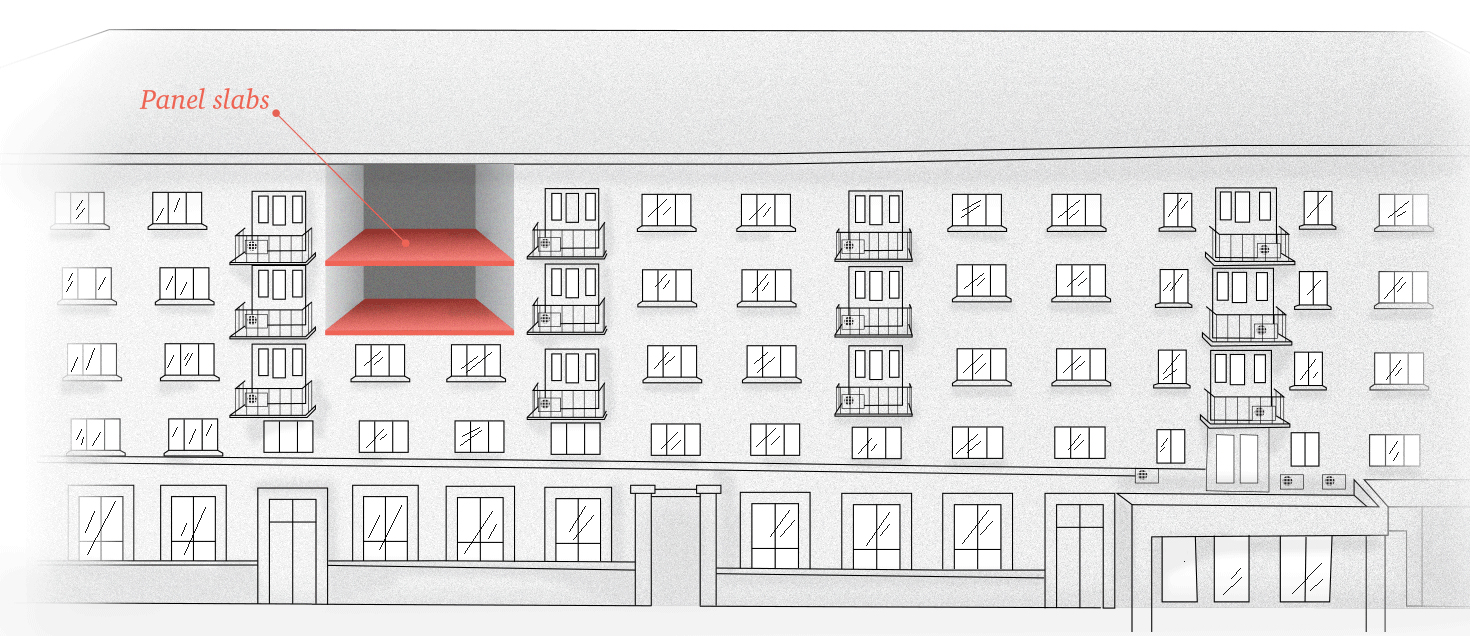How Russian strikes destroy high-rise buildings

How Russian strikes destroy
high-rise buildings
8 examples with comments
from a civil engineer
Translated by Dmitry Lytov, Mike Lytov
Since the beginning of the large-scale invasion of Russia on February 24 and the related hostilities in Ukraine, almost 121 thousand residential buildings, in which about a million families lived, have already been damaged and destroyed. About 13,000 of them are large apartment buildings. Total losses amount to $36.8 billion as of July 13, according to the estimate of the "Russia will pay" project of the Kyiv School of Economics.
TEXTY decided to use the examples of specific buildings to look at exactly how destruction occurs during shelling or fire, and which of them are or are not subject to restoration. Dmytro Makagon, architectural engineer, looks at photos and videos of damaged buildings with us and comments on them.
First of all, the results of hitting even identical buildings (for example, two-panel apartments or two monolithic high-rise buildings) are difficult to compare. The nature and scale of the destruction depend very much on the type of projectile, the volume of explosives, the number of hits, the point of impact, the general condition of the building itself (from new to disrepair), etc.
Secondly, during their design stage, buildings are not expected to be tested for missile or aerial bomb impacts. The simulation considers household explosions or destruction due to fire at most. Therefore, there are no "standard" calculations of how houses of various types should react, for example, to being hit by a Russian "Caliber" missile or a FAB-500 aerial bomb, because neither of these should normally happen with residential buildings.
Thirdly, the strength parameters of the house, which the architect calculates, are aimed at ensuring that it does not collapse like a house of cards at the moment when destruction occurs. In construction terms it is called protection against progressive destruction. That is, if suddenly a wall or a column is knocked out on a floor, this should not affect the strength and stability of the rest of the floors. However, this does not mean that an impact-damaged building that survived is still habitable. To put it simply, the designer's task is to buy residents time to evacuate, not to design a "perpetual” and “indestructible" house.
We took 8 buildings from different regions, damaged at different times and by different types of weapons. Using these examples, Dmytro Makagon explains where design flaws led to such large-scale destruction, and where, on the contrary, they saved the building from complete destruction.

Monolithic apartment buildings. Kyiv and Odesa
On February 26, a Russian missile hit a high-rise building near Zhuliany airport, “biting off” a portion of floors 17-20. 2 people died, 4 were injured. After the examination, the local authorities decided that the floors above the impact site would be dismantled. Dismantlement would be carried out from the air, carefully cutting out small pieces of concrete structures. The construction is planned to be completed before the beginning of the heating season.

Kyiv

Kyiv

Kyiv
Dmytro Makagon (D.M.): "The fact that the building stood and did not collapse after the missile strike indicates that it was probably erected in compliance with modern construction standards, which take into account the aspect of progressive destruction. That is, even if several columns and walls are destroyed by an explosion, the building itself does not collapse. Modern high-rise buildings are the strongest in this regard. They have "cores of rigidity" made of concrete — these are elevator and staircase units. The taller the building, the thicker the columns should be in order to withstand the weight of the building and wind loads. And the larger the column of the wall, the better it can potentially withstand side explosions. The example of the house in Tatarka, where the rocket hit the first floors, also confirms this.And this is not some invention of recent years, these are norms that have been applied to high-rise buildings for a long time. For example, the television center (known as "Olivets", or The Pencil) and the building of the Ministry of Infrastructure, built in Soviet times, also have such "cores of rigidity".
Of course, this does not mean that any 25-story high-rise will withstand any missile attack. Even if it has survived this specific missile, it may not survive an "Iskander"."
On April 23, Odesa suffered a rocket attack. The Russian military hit the fourth entrance, between the fourth and fifth floors, with a rocket. The projectile was launched from the Tu-95 aircraft, which was in the waters of the Caspian Sea. Fires started in at least two apartments of the "Tiras" housing complex. The rocket went through the house. 8 people died, 18 were injured. 30 apartments belonging to Odesa residents were completely destroyed, and another 62 were damaged to varying degrees. The authorities decided that the building can be restored. In May, the structures were strengthened and the building was stabilized, which helped stop its further destruction. On the 20th of July, local media published information saying that part of the complex has already been rebuilt.

Odesa

Odesa

Odesa
D.М.: "Odesa is special in the sense that the southern regions of Ukraine implement even stricter requirements for the strength of buildings. After all, there is a possibility of seismic activity, so the buildings must be even more stable. The building built in 2012, which was hit by a rocket, just like the high-rise in the capital, did not collapse precisely because of the presence of a "core of rigidity". Of course, we have not seen the results of the examination and do not know the full description of the nature of the destruction, and we did not conduct research, but visually the "torn" part of the house appears to be restorable without the dismantlement of the entire entrance."
Panel apartments. Borodyanka and Mariupol
There are no exact dates for when the buildings in the center of the town of Borodyanka near Kyiv and similar panel apartment buildings in one of the residential areas of Mariupol were destroyed, just as there is no reliable data on the source of the destruction: it could equally have been air bombs, or artillery fire. Dozens of people could have died under the rubble. Photos of these buildings were shared by media worldwide, partly due to a peculiar and striking structural feature: when the entire entrance collapsed due to damage, on the upper floors, individual wall panels were left hanging as if in weightlessness. These buildings are subject to complete demolition.

Borodyanka

Borodyanka

Borodyanka
D.М.: "Old houses — and this applies not only to panel structures — are not designed to prevent progressive destruction. In the case of concrete panel objects, a bomb could destroy only one or two upper floors. But as soon as those panels are destroyed, they begin to fall on top of each other and turn into a "projectile" themselves. And the taller this building is, the more the "collapsed" upper panels will press on the lower floors and also cause destruction. There is also the danger that the wall panel can be knocked out by an explosion because it rests on collateral parts. Then, the absence of one panel can cause the entire section to collapse. In this way, the entire section "folds down" not only because of the destructive power of the bomb or missile (although this can also be a factor), but because of the features of the design. This also applies to domestic accidents, for example, a gas explosion.

Mariupol

Mariupol

Mariupol
Additionally, we can see the consequences of the fire in the photo. Concrete and steel reinforcements can be destroyed, and the ceiling can collapse (“fold down”) from high temperatures. It is very difficult to determine what share of this destruction is because of the direct impact of the bomb, and which part was done by the ensuing fire. The panels, which were accidentally left "hanging" on the upper floors, no longer rest on other panels, nor carry the ceiling, but only "carry" themselves. The load on them is small, so when the rest of the section "got out", they were left hanging. This is, of course, only for a while. Because one way or another, the fasteners are deformed, and sooner or later they will collapse, unless people do not dismantle or demolish them. Unfortunately, most likely, the buildings shown in the photo are subject to complete demolition, as the destruction and fire, most likely, have damaged the entire structure."
Brick buildings. Chasiv Yar, Kharkiv, Chernihiv
On July 10, Russian rockets landed in the town of Chasiv Yar in the Donetsk region, destroying, among other things, a brick dormitory building. 48 people died from the raids. The next day, the occupiers targeted a similar brick building from the 1960s in the historical center of Kharkiv, without any casualties. In both cases, entire sections were destroyed. The "Ukraine" hotel in Chernihiv, which the Russians attacked on the night of March 12, is also made of brick. Initially, it was believed that an aerial bomb had been dropped on the hotel, but later the wreckage of an "Iskander" missile was found on the territory. The Russians even filmed a propaganda story about it, which featured a clichéd story about “foreign mercenaries” who were purportedly staying in the hotel.

Chasiv Yar

Chasiv Yar

Chasiv Yar
D.М.: "One can notice on the photo from Chasiv Yar that panel slabs were overlapping in those houses. That is, if a broken slab falls down and crashes on another slab below, the effect continues and makes the entire structure collapse. Panel apartments, where the walls are made of reinforced concrete, are similar by design to brick houses, which also have overlapping panel slabs. 4 powerful missiles hit a dormitory in Chasiv Yar, hardly anything would have survived there, even if the ceilings were monolithic, as in modern houses. The bricks experience the load from the blast wave worse than concrete.

Kharkiv

Kharkiv

Kharkiv
In the building from the photo taken in Kharkiv, it seems that the brick wall on which the floors rested was destroyed. And so they collapsed, breaking through the lower floors. When the floors lost their support, they in turn also collapsed. If the building featured monolithic overlapping, this would not have happened, or at least there would have been more chances for the building to survive, that is, the impact of the explosive wave from the rocket could have been insignificant. By and large, it is possible to disassemble the part which was destroyed, and the rest of the house can most likely be restored. Judging by the photo, there was no fire, only destruction from the impact. But of course, each specific case should be considered separately. The tilt of the building due to the shockwave is not visible to the human eye, it must be measured with instruments.

Chernihiv

Chernihiv

Chernihiv
The hotel in Chernihiv is structurally similar: brick walls and concrete floor slabs are strips that were displaced by the impact of an aerial bomb. It seems that everything, down to the first floor, was destroyed. The destruction follows the contour of the crater, meaning the blast wave acted in the same way as if this bomb had fallen to the ground. That is, the epicenter coincides with the deepest damage and from there it spreads further to higher floors. Here we see that the walls are quite strong and thick, and thanks to this, while the slabs were torn apart, the walls remained due to their thickness. Of course, everything here will be demolished."
"Irpinski Lypky" residential complex
TEXTY have already reported on one of the most famous destroyed houses in Irpin near Kyiv in the "Irpinski Lypky" (Lindens of Irpin) housing complex, which was shown to international delegations during regular tours to the places of atrocities committed by Russian soldiers in the capital's suburbs in February-March, as well as about the prospects for the restoration of the town and its surroundings. According to Dmytro Makagon, the building appeared to have been more so damaged by the fire than by the explosions, and therefore is subject to complete demolition.

Irpin

Irpin

Irpin
D.М.: "Here we see characteristic signs of destruction caused by fire. When the concrete was heated, the reinforcement was exposed. If it was a peaceful time and the relevant services were working, they should have quickly localized and extinguished the fire in 1-2 hours. But when the fire burns for half the day, it is no longer possible to restore, due to the fact that it is not known how the armature behaved at a high temperature. Of course, it does not melt like the Terminator in the movie, but 500 C (about 930 F) is enough for it to begin to deform and expand. This leads to cracks in the concrete, and its pieces begin to break off. That is, the structure no longer meets the requirements of safety and reliability."
The best defense against a missile impact is not the maximum fortification of walls, but the measures that better prepare for such an impact. Regardless of whether the house will become the target of the enemy or will be an "accidental victim", the scale of destruction can only be estimated in advance. More modern houses offer a better chance of salvation for more people. However, they do not guarantee complete security. This should be kept in mind when choosing a shelter during an air raid and a possible missile attack.
For the details, look at the pictures in the gallery below









